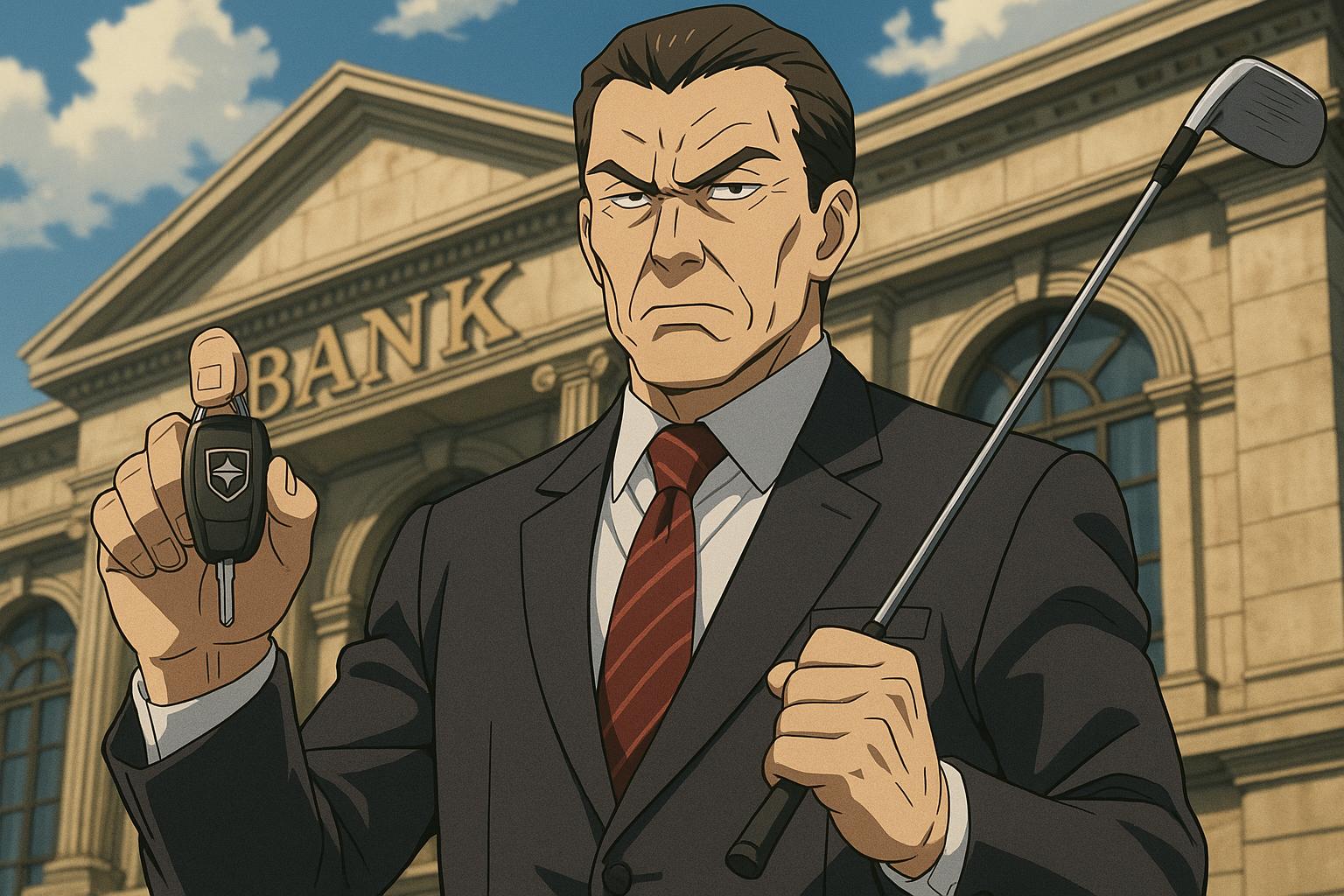Former RBS chief executive Fred Goodwin, notorious for his role in the bank’s downfall, continues to receive a hefty pension of nearly £600,000 a year, reigniting controversy over taxpayer-funded executive rewards and the long-lasting impact of corporate mismanagement on the UK economy.
The familiar face of Fred Goodwin, once the chief executive of the Royal Bank of Scotland (RBS), has resurfaced in public at an Italian bistro in Glasgow, evoking curiosity about the legacy of a man who once epitomised corporate ambition and colossal failure. Known for his ruthless management style and dubbed ‘Fred the Shred,’ Goodwin’s rise was meteoric, transforming RBS into the largest bank in the world before its catastrophic collapse led to a historic taxpayer bailout.
Goodwin’s tenure was marked by lavish expenses that included a £5.3 million refurbishment of a rarely used Edinburgh property, famously termed the “Pleasure Dome.” These extravagances became notorious, overshadowing his achievements. They spurred a public outcry, especially after the bank’s collapse triggered a £45 billion government bailout—the largest in British history—which left taxpayers holding an 83 per cent stake. After witnessing the fallout of his decisions, including a staggering £24.1 billion loss in 2008, Goodwin’s reputation deteriorated sharply, resulting in the revocation of his knighthood by the Queen in 2012.
Despite the controversy surrounding his leadership, Goodwin has maintained a gilded lifestyle, funded by a pension that has become a symbol of corporate excess. Initially, he walked away with a £16 million pension pot, yielding £700,000 a year, which was later halved to £342,500 following public discontent. Recent estimates suggest that Goodwin now receives nearly £600,000 annually, thanks to inflation-linked adjustments to his pension. Critics, such as John O’Connell from the TaxPayers’ Alliance, have articulated their disbelief that taxpayers are still subsidising the lavish retirement of a man whose actions precipitated significant financial turmoil.
The fallout from Goodwin’s decisions continues to reverberate through the banking sector. RBS, now part of NatWest, is only just on the cusp of returning to full private ownership, with the government anticipated to incur a £10 billion loss despite the eventual sale of its remaining shares. This failure to fully recuperate public funds highlights the enduring financial damage wrought by Goodwin’s mismanagement and raises questions about accountability in the banking industry.
As he sat amid the intimate ambience of Caprese Don Costanza, reports indicated that Goodwin appeared relaxed and jovial, seemingly unfazed by the shadows of his past. His physical appearance contrasted sharply with the man who once provoked public protests and hostility. Friends in high places have helped him navigate his quieter existence, allowing him to retreat into relative anonymity. Today, he indulges in personal interests like collecting classic cars and golfing at exclusive clubs, activities which are well within the means afforded by his continuing pension payments.
However, the human cost of Goodwin’s reign remains palpable. Many former RBS employees and ordinary savers grappled with the financial implications of the bank’s collapse, having lost pensions and savings accumulated over decades. Goodwin’s personal life has also been stained by professional misconduct, including an extramarital affair that led to the demise of his marriage. His second act has not provided the professional redemption he may have hoped for; consultancy roles have fizzled out, and he remains largely disconnected from the corporate world that once lauded him.
The narrative surrounding Fred Goodwin serves as a compelling case study in corporate governance, reflecting the need for stringent measures to ensure accountability among executive leaders. While he may have retreated from the public eye, the memories of his flamboyant lifestyle and the catastrophic outcomes of his tenure continue to haunt a banking sector striving for stability in a post-crisis world.
Reference Map:
Source: Noah Wire Services
- https://www.dailymail.co.uk/news/article-14766195/A-600-000-year-pension-stunning-luxury-home-time-world-enjoy-wonder-Fred-Shred-RBS-laughing-bank.html?ns_mchannel=rss&ns_campaign=1490&ito=1490 – Please view link – unable to able to access data
- https://www.theguardian.com/business/2009/jun/18/rbs-sir-fred-goodwin-pension – In June 2009, Sir Fred Goodwin, former CEO of the Royal Bank of Scotland (RBS), agreed to reduce his annual pension from £555,000 to £342,500, following public outcry over his £16 million pension pot. Despite this reduction, unions and business experts criticised the deal, arguing it still rewarded failure during a financial crisis. Goodwin had previously taken a £2.8 million tax-free lump sum and a £2.6 million bonus in his final year at RBS. The bank’s internal inquiry found no wrongdoing on his part, but the pension remained a contentious issue.
- https://www.theguardian.com/business/2009/jun/18/fred-goodwin-rbs-pension – In June 2009, Sir Fred Goodwin, former CEO of the Royal Bank of Scotland (RBS), agreed to reduce his annual pension from £555,000 to £342,500, following public outcry over his £16 million pension pot. Despite this reduction, unions and business experts criticised the deal, arguing it still rewarded failure during a financial crisis. Goodwin had previously taken a £2.8 million tax-free lump sum and a £2.6 million bonus in his final year at RBS. The bank’s internal inquiry found no wrongdoing on his part, but the pension remained a contentious issue.
- https://www.bbc.com/news/uk-politics-16821650 – In February 2012, former RBS CEO Sir Fred Goodwin had his knighthood revoked by the Queen, following advice from the government. The decision was based on the significant impact of his actions during his tenure, which led to RBS’s near-collapse in 2008 and a £45 billion taxpayer bailout. The government stated that retaining the knighthood was not sustainable due to widespread concern over Goodwin’s decisions. Both Prime Minister David Cameron and Labour leader Ed Miliband welcomed the move, emphasising the need for accountability in corporate governance.
- https://www.theguardian.com/business/2009/feb/26/sir-fred-goodwin-royalbankofscotlandgroup – In February 2009, it was revealed that Sir Fred Goodwin, former CEO of the Royal Bank of Scotland (RBS), was receiving an annual pension of £650,000 at the age of 50. This disclosure came shortly after RBS announced a record £24.1 billion loss, the largest in UK corporate history. The revelation sparked public outrage and led to calls for the government to recover some of the pension funds. Chancellor Alistair Darling stated that legal avenues were being explored to address the situation, while opposition politicians criticised the government’s handling of the matter.
- https://www.thisismoney.co.uk/money/markets/article-12710041/Former-RBS-boss-Fred-Shred-Goodwin-enjoying-500k-gold-plated-pension.html – As of 2018, former RBS CEO Sir Fred Goodwin was reported to be receiving an annual pension of approximately £545,000, up from £342,500 in 2009. This increase was attributed to inflation adjustments. The pension, linked to RBS’s pension scheme rules, was estimated to be worth around £14 million if Goodwin were to purchase an equivalent annuity. The substantial pension continued to attract criticism, with commentators highlighting the contrast between Goodwin’s lucrative retirement and the financial difficulties faced by ordinary savers during the financial crisis.
- https://www.thisismoney.co.uk/money/markets/article-6169589/Fred-Shred-line-17m-pension.html – In September 2018, it was reported that former RBS CEO Sir Fred Goodwin was in line for a £17 million pension, with an annual income of £450,000. This substantial pension was a result of his tenure at RBS, which included aggressive expansion and the controversial acquisition of ABN Amro. The pension continued to be a point of contention, with critics highlighting the disparity between Goodwin’s retirement benefits and the financial challenges faced by the bank and its stakeholders during the financial crisis.
Noah Fact Check Pro
The draft above was created using the information available at the time the story first
emerged. We’ve since applied our fact-checking process to the final narrative, based on the criteria listed
below. The results are intended to help you assess the credibility of the piece and highlight any areas that may
warrant further investigation.
Freshness check
Score:
3
Notes:
 The narrative largely recycles well-established information about Fred Goodwin’s pension and lifestyle, with no significant new developments reported. The earliest known publication date of similar content is 2009, with updates in 2018 and 2023. ([theguardian.com](https://www.theguardian.com/business/2009/jun/18/rbs-sir-fred-goodwin-pension?utm_source=openai), [thisismoney.co.uk](https://www.thisismoney.co.uk/money/markets/article-12710041/Former-RBS-boss-Fred-Shred-Goodwin-enjoying-500k-gold-plated-pension.html?utm_source=openai))
The narrative largely recycles well-established information about Fred Goodwin’s pension and lifestyle, with no significant new developments reported. The earliest known publication date of similar content is 2009, with updates in 2018 and 2023. ([theguardian.com](https://www.theguardian.com/business/2009/jun/18/rbs-sir-fred-goodwin-pension?utm_source=openai), [thisismoney.co.uk](https://www.thisismoney.co.uk/money/markets/article-12710041/Former-RBS-boss-Fred-Shred-Goodwin-enjoying-500k-gold-plated-pension.html?utm_source=openai))
Quotes check
Score:
2
Notes:
 The quotes attributed to John O’Connell from the TaxPayers’ Alliance and other sources appear to be reused from previous reports, with no new statements or verifications provided.
The quotes attributed to John O’Connell from the TaxPayers’ Alliance and other sources appear to be reused from previous reports, with no new statements or verifications provided.
Source reliability
Score:
4
Notes:
The narrative originates from the Daily Mail, a publication known for sensationalism and occasional inaccuracies. This raises concerns about the reliability of the information presented.
Plausability check
Score:
5
Notes:
While the claims about Goodwin’s pension and lifestyle are plausible, the lack of new evidence or updates, combined with the sensational tone, suggests potential exaggeration or selective reporting.
Overall assessment
Verdict (FAIL, OPEN, PASS): FAIL
Confidence (LOW, MEDIUM, HIGH): HIGH
Summary:
 The narrative fails to provide fresh or original information, relying heavily on recycled content from previous years. The use of sensational language and the questionable reliability of the source further diminish its credibility. ([theguardian.com](https://www.theguardian.com/business/2009/jun/18/rbs-sir-fred-goodwin-pension?utm_source=openai), [thisismoney.co.uk](https://www.thisismoney.co.uk/money/markets/article-12710041/Former-RBS-boss-Fred-Shred-Goodwin-enjoying-500k-gold-plated-pension.html?utm_source=openai))
The narrative fails to provide fresh or original information, relying heavily on recycled content from previous years. The use of sensational language and the questionable reliability of the source further diminish its credibility. ([theguardian.com](https://www.theguardian.com/business/2009/jun/18/rbs-sir-fred-goodwin-pension?utm_source=openai), [thisismoney.co.uk](https://www.thisismoney.co.uk/money/markets/article-12710041/Former-RBS-boss-Fred-Shred-Goodwin-enjoying-500k-gold-plated-pension.html?utm_source=openai))













